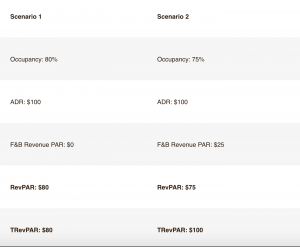
Revenue per available room, or RevPAR, has historically been the most widely used metric for benchmarking performance in the hospitality industry. Its success as a key performance indicator or KPI is the result of its efficiency and simplicity. RevPAR is efficient because it combines the results of both occupancy and average rate into one number. And it’s simple, because all you need to calculate it is occupancy and average rate:
RevPAR = Occupancy * ADR
But its simplicity and straightforwardness conceal its faults and limitations. Here are three reasons you can’t put all your eggs in the RevPAR basket:
1. RevPAR does not measure a hotel’s ability to generate revenue
RevPAR only encompasses revenue derived from the operation of rooms. This means that any ancillary revenue—F&B, spa, parking, golf, etc.—is left out of the analysis. A more all-inclusive KPI is total revenue per available room, or TRevPAR, which considers all of the revenue streams in a hotel and is therefore a more accurate indicator of a hotel’s revenue generation. For example, let’s look at two different scenarios:
If our analysis focused exclusively on RevPAR, we might think that the hotel was more efficient at generating revenue in Scenario 1. However, by incorporating all revenue streams, in this case food and beverage, we see that Scenario 2 generated more revenue. Complex operations will see that “RevPAR bias” distorts the truth about a hotel’s revenue-generating success. Consequently, RevPAR should not be used as the “end-all be-all” global revenue metric.
2. RevPAR is not a measure of financial health
Financial health is dictated by the ability of an operation to turn revenue into profit; what is oftentimes referred to as “flow through.” RevPAR is concerned solely with the money coming into the operation through the rooms department, and it’s blind to all of its associated costs (commissions, supplies, utilities, labor and more). Therefore, RevPAR shows a very limited picture of the financial results of a hotel. The most suitable metric to track and benchmark when looking at profitability is gross operating profit per available room, or GOPPAR, because it captures total revenue and expenses.
3. RevPAR is just one step in the evolution of hotel analytics
RevPAR, of course, has its place in hospitality metrics. It remains a very popular indicator of performance, but it by no means illustrates the whole picture of a hotel’s performance and, when teased out further, the overall health of the hospitality industry.
Historically, hoteliers tracked average room rate and occupancy to understand how they fared against their competitors. These were the two easiest metrics to track: Managers would ask employees to count the cars in their competitors’ parking lots as a proxy for occupancy, or they would call each other requesting rate information. Granted, these numbers were not reliable, but they were still better than nothing.
As technology evolved, the possibility of systematically sharing and collecting top-line information in an anonymous way increased the accuracy of the data and prompted more in-depth analyses. Subsequently, RevPAR, which captures the trade-off between occupancy and rate, became the biggest game in town—a way for hotel owners to evaluate operators and an easy way for Wall Street to judge publicly traded hotel companies and REITs. It was the only game in town, but the street is now getting more crowded.
Data that tracks revenue beyond rooms and also expenses is now available, allowing hotels to benchmark against different KPIs and gather a more complete picture of their operation. For example, departmental profit, labor costs as a percentage of total revenue, rooms cost of sales and GOPPAR provide relevant insights into cost-saving strategies that can enhance flow through when revenue exceeds budget and allow hoteliers to succeed in a “flex situation” when revenues are less than budget.
RevPAR is a very good tool to track and benchmark rooms revenue and it’s excellent for tactical pricing. However, there is a world of KPIs available beyond RevPAR that can help hoteliers make sense of the complexity of hotel operations. Focusing on RevPAR as the main indicator of performance only leads to biased analyses and missed opportunities to maximize profitability.


